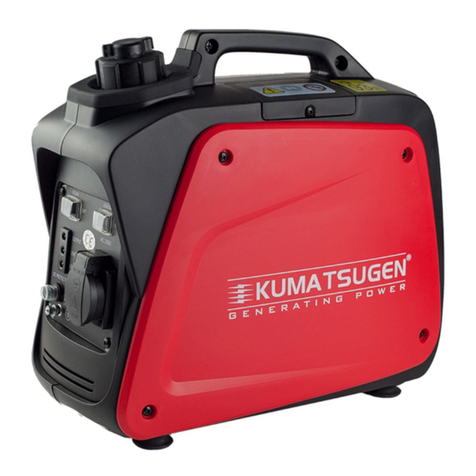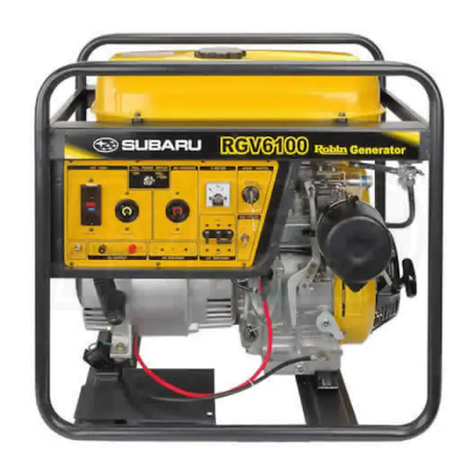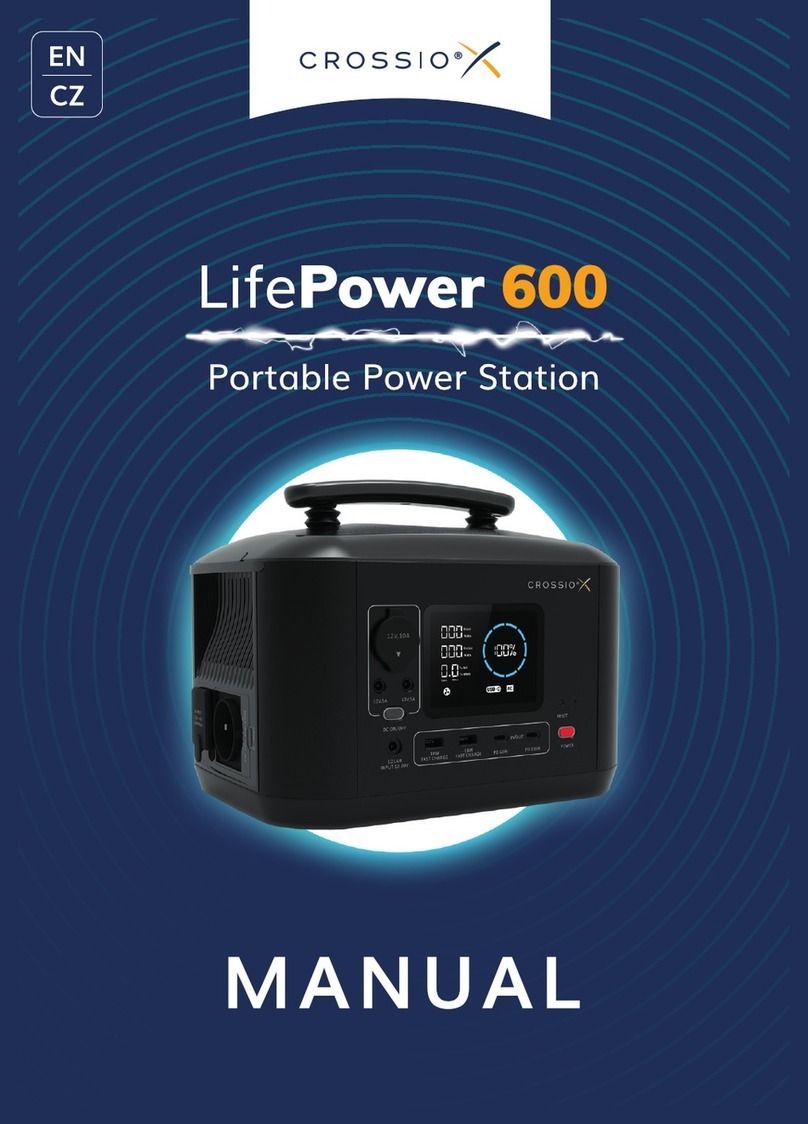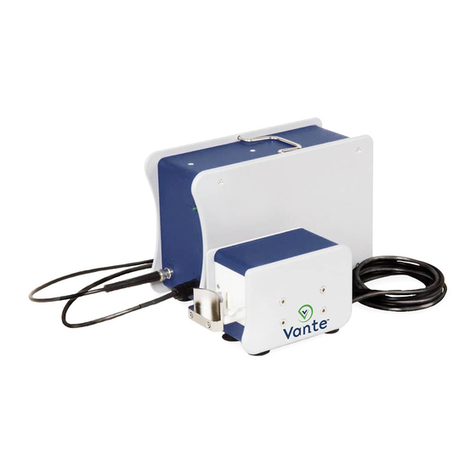B&K E-200D User manual

MANUAL Model E-200D
RF Signal Generator
AProduct of DYNASCAN CORPORATION 1801 West Belle Ptaine Chicago, Illinois 60613
PRICE $2.00

Dear Friend:
Congratulations on your purchase of B<S K—Precision Test Equipment, and
welcome to the B& K family. We hope your experience with your new test equip-
ment will make you alifetime B&Kcustomer.
Your instrument is backed by more than 20 years of experience in designing
and manufacturing. Our most important goal is your satisfaction. At B&K, test
equipment is made to meet the demands of the field, focusing on dependability and
acciuacy. We also concentrate on simplicity and operating ease with features that
reduce the possibility of human error and speed the servicing process.
In order to determine the type of test rmits that ore needed we have been guided by letters and reports
from technicians and engineers who use the equipnnent daily. Orir field tests and studies have helped provide
better and faster service techniques. Close contact has been maintained with the manufacturers of consumer
products which our test units will be checking and trouble-shooting.
Key personnel in our company cut th^ eye teeth in the TV service business. This is why we have more
"sensitivity" for the problems and conditions under which the test equipment will be used.
B<& Kproduct designs are constantly reviewed, and refinements ore made or new models developed to
meet advances in our industry and to fill your needs. We set our standards high so you can be assured that
the B<S Ktest instruments you buy represent advanced design, quality construction, and dependable long-
term performance at aprice you can afford.
If you have any comments or thoughts about our products, or test equipment in general, Iwould be
delighted to hear from you.
Thanks for your confidence in B&Kand we look forward to serving you for along time to come.
Sincerely,
O^/c'^—
Carl Kom
President

INSTRUCTION MANUAL
FOR
B&k/precision
MODEL E-200D
RFSIGNAL GENERATOR
B&KDIVISION OF DYNASCAN CORPORATION
1801 W. Belle Plaine Avenue
Chicago, Illinois 60613


B&K/PRECISION MODEL E-200D
RFSIGNAL GENERATOR
TABLE OF CONTENTS
Page
SPECIFICATIONS 4
FEATURES 5
OPERATOR'S CONTROLS AND INDICATORS 7
OPERATING INSTRUCTIONS 8
Preliminary Set-up 8
Setting the Signal Level 8
Setting Modulation 8
ALIGNING AM BROADCAST BAND RECEIVERS 11
ALIGNING FM BROADCAST BAND RECEIVERS 12
ALIGNING TELEVISION RECEIVERS 14
Sound IF 14
Video IF 14
Tuner Adjustment 14
USING THE RF SIGNAL GENERATOR TO LOCATE TROUBLES 15
OTHER USES FOR THE RF SIGNAL GENERATOR 16
Alignment 16
Measuring Gain 16
Measuring Bandwidth 16
CIRCUIT DESCRIPTION 18
CALIBRATION OF 100 KHz OSCILLATOR 18
WARRANTY SERVICE INSTRUCTIONS 20

SPECIFICATIONS
FREQUENCY
RANGE
100 kHz to 54 MHz in five funda-
mental bands.
32 MHz to 216 MHz in two har-
monic bands.
BAND A100 kHz to 370 kHz
BAND B370 kHz to 1400 kHz
BAND C1.4 MHz to 5.1 MHz
BANDD 5.1 MHz to 16 MHz
BANDE 16 MHz to 54 MHz
BAND Hj 32 MHz to 108 MHz
(harmonic)
BAND H4 64 MHz to 216 MHz
(harmonic)
FREQUENCY
ACCURACY ±1.5% of highest frequency on
any given band, usable to ±-
0.1% with crystal calibrator.
Output open circuited, meter un-
calibrated:
BAND A3Vrms minimum
BAND B2Vrms minimum
MAXIMUM BAND C0.6 Vrms minimum
OUTPUT LEVEL BANDD 0.3 Vrms minimum
BANDE 0.3 Vrms minimum
BANDH2 uncalibrated har-
monic output
BANDH4 uncalibrated har-
monic output
—106 dB (0.5 microvolt) to +2dB
(126,000) microvolts) into 50-ohm
CALIBRATED load. Carrier meter covers —10
OUTPUT to +2dB range (reference 0dB =
100,000 microvolts into 50-ohm
load); attenuators extend range to
—106 dB.
CALIBRATED
OUTPUT ±1 dB 100 kHz to 54 MHz
ACCURACY
ATTENUATORS Six step attenuators of 20 dB, 20
dB, 20 dB, 20 dB, 10 dB and 6dB
(96 dB total) plus fully adjustable
fine attenuator control.
MODULATION
TYPE CW or amplitude modulation
INTERNAL
MODULATION 400 Hz ±20% from bridged "T"
two-stage oscillator; adjustable
level.
EXTERNAL
MODULATION
SENSITIVITY
Approximately 1Vrms for 50%
modulation at 400 Hz.
MODULATION
METER
Reads 0to 50% modulation for
internal or external modulation:
accuracy ±5% from 100 kHz to
30 MHz.
CRYSTAL
CALIBRATOR
Crystal calibration points every 1
MHz and 100 KHz (derived). Ac-
curacy 0.05%. Built-in detector,
amplifier and speaker for "zero
beating".
400 Hz
OUTPUT
Output of internal modulation os-
cillator available for external use
at EXT MOD jacks.
Level: 1.25 volts maximum
Impedance: 5K ohms at maximum
level.
Distortion: Less than 0.5%
POWER
REQUIREMENTS 117 VAC, 50/60 Hz, 6 watts
SIZE 12 %" wide X7%" high x8" deep
SHIPPING
WEIGHT Approximately 14 pounds

FEATURES
WIDEST
FREQUENCY
RANGE
Continuous coverage from 100 kHz
to 216 MHz in seven frequency
bands (54 MHz to 216 MHz signals
use harmonic output). No gaps in
coverage. Covers AM broadcast
band, FM broadcast band, am-
ateur, short wave and two-way
communications bands, and all
VHF television channels, plus all
i-f frequencies.
FULLY
SOLID
STATE
Uses 18 semiconductor devices for
all the advantages of solid state
technology; reliability, rugged-
ness, instant warm-up, low power
consumption, no high voltage,
light weight and compactness.
FULLY
SHIELDED
Oscillators and attenuators are
shielded to reduce "spray" radi-
ation; aneccessity when testing
and aligning high sensitivity
receivers.
SINUSOIDAL
OUTPUT Sinusoidal rf output signal has
very low distortion on funda-
mental output ranges to 54 MHz.
VERNIER
SCALE
TUNING
A6.1 gear reduction ratio be-
tween the tuning knob and the
dial allows the dial to be easily
and accurately set.
EASY-TO-READ
DIAL
Alarge circular two-color dial (15-
inch circumference with seven
separate frequency scales pro-
vides easy, accurate direct fre-
quency readings.
Key frequencies and frequency
ranges ore identified: Broadcast
receiver i-f; FM i-f; TV i-f sound
and video frequencies; FM band;
VHF TV Video Carrier frequencies
for all 12 VHF channels.
CALIBRATED
OUTPUT
LEVEL
Acarrier level meter and step
attenuators provide accurately
calibrated output level measure-
ment from —106 dB to +2 dB (0.5
uV to 126,000 uV) when using the
50-ohm terminated cable that is
supplied with the instrument.
ADJUSTABLE
MODULATION
Amodulation percentage meter
and modulation level adjustment
permit calibrated modulation from
0to 50%, with higher uncalibrated
levels (up to 100%) possible.
FREQUENCY
ACCURACY
Abuilt-in crystal controlled oscil-
lator, "zero beat" circuit and ad-
justable cursor marker provide
dial accuracy of 0.1%.
INTERNAL
MODULATION Internal 400 Hz oscillator pro-
vides low distortion modulation
voltage.
400 Hz
OUTPUT
The output of the 400-Hz oscilla-
tor is available at the external
modulation jacks for use as an
audio test signal. Thus, the sig-
nal generator can be used for
complete testing of both the rf
and audio sections of areceiver.
The level is fully adjustable from
0to 1.25 volts rms.
PILOT
LAMP
EASE OF
OPERATION
Lets you tell at aglance whether
instrument is on or off.
Controls and indicators are "op-
erator designed". Related con-
trols are grouped, lettering is
easy to read and "explains"
rather than confuses. Simplified
control layout for calibration ac-
curacy eliminates complicated
conversion tables and graphs for
precision frequency and output
level settings.
5

ATUMUAIO*
ATTIMUUkTOt
utnn
CAL1B«AT0M
VWO«Hi
I^IQPOLATION^
100 H;
Figure 1. Operator's Controls and Indicators

OPERATOR’S CONTROLS AND INDICATORS
(Refer to Figure 1)
1.
Pilot lamp—Lights continuously when signal
generator is turned on.
2.
METER switch
%MOD position—Connects meter to meas-
ure percentage of modulation.
CARRIER position—Connects meter to meas-
ure carrier (rf output signal) level.
3.
Meter—Indicates carrier level in dB on top (red)
scale or percentage of modulation on bot-
tom (black) scale. Use the scale which
corresponds to the METER switch position.
NOTE
The rf output must be terminated in a
50-ohm lead when using the carrier scale
for calibrated output level.
4
.
MOD LEVEL control—Adjusts percentage of
modulation for internal or external modu-
lation. Adjusts level of 400-Hz tone output
when MODULATION switch is in 400 Hz
OUT position.
5.
Dial—Indicates the frequency of the output sig-
nal. Use the scale which corresponds to
the RANGE switch position.
6.
Frequency control—Adjusts the dial frequency.
7.
Cursor marker adjustment—Adjusts the cursor
marker for highly accurate frequency read-
ings when used with the crystal calibrator.
8. RANGE switch—Selects the frequency range
for the output signal as follows;
Range A—100 kHz to 370 kHz
Range B—370 kHz to 1400 kHz
Range C—1.4 MHz to 5.1 MHz
Range D—5.1 MHz to 16 MHz
Range E—15 MHz to 54 MHz
Range Hj—30 MHz to 108 MHz
Range H|—60 MHz to 216 MHz
9. FINE ATTENUATOR control—Fine setting of
output level.
10.
ATTENUATOR selectors—Coarse setting of out-
put level. Six individual attenuators of 20,
20, 20, 20, 10 and 6dB permit steps from 0
to 96 dB. Each switch has two positions as
follows:
IN position—adds attenuation
OUT position—removes attenuation
11.
RF OUT jack —Connector for output signal.
Mates with microphone type connector.
12.
RF output cable—Connects output signal to
equipment being tested or aligned. Cable
contains 50-ohm termination. Use an un-
terminated coble if the output is being fed
directly to a50-ohm circuit.
13.
XTAL CALIBRATOR switch
1MHz position—Provides crystal calibration
at each multiple of IMHz.
OFF position —disables calibration oscilla-
tors.
100 KHz position—Provides crystal calibra-
tion points at each multiple of 100 kHz.
14.
Speaker (behind dial)—Provides audible "zero
beat" for crystal calibration procedure.
15.
MODULATION switch
AC OFF position—turns off unit. Unit is on in
all other positions.
CW position —Provides unmodulated CW
(continuous wave) output.
INT position —Provides 400 Hz internally
modulated output.
EXT position—Provides externally modulated
output. The external modulation voltage is
connected to EXT MOD jacks when using
this switch position.
400 Hz OUT position—Provides 400-Hz output
at the EXT MOD jacks.
16.
MOD jacks—Input jacks for external modula-
tion and output jacks for 400-Hz tone. Uni-
versal binding post type jacks accept ba-
nana plug, meter leads, spade lugs, etc.
Black post is grounded, red post is audio
high.
7

OPERATING INSTRUCTIONS
PRELIMINARY SET-UP
1. Connect the plug of the ac power cord to a117-
volt, 50/60 Hz ac power outlet.
2. To turn on the signal generator, set the MOD-
ULATION switch 15 to the CW position. The pilot
lamp 1should light.
3. Set the XTAL CALIBRATOR switch 13 to the OFF
position.
4. Set the RANGE switch 8to the desired frequen-
cy range.
5. Set the dial 5to the desired frequency with the
frequency control knob 6
6. Connect the rf output cable to the RF OUT
jack 11. The cable supplied with the signal gen-
erator is normally used. It contains abuilt-in
50-ohm termination. However, if the rf output
signal is to be applied directly to a50-ohm cir-
cuit, an unterminated rf cable should be used.
Such acable can be made from alength of 50-
ohm coaxial cable (RG-58A/U) terminated in a
microphone type female connector on one end
and the desired connector or terminations on
the other end.
7. Connect the rf output cable to the equipment
being tested. Connect the black lead to the
chassis first, then the red lead to the signal
injection point.
PRECAUTIONS
A. When performing stage-to-stage measure-
ments, always use adc blocking capacitor
between the red probe of the rf output cable
and the circuit into which the signal is in-
jected. This protects the attenuators of the
signal generator from possible damage by
the dc from the circuit under test. Trim the
capacitor leads as short as possible, while
still permitting adequate length for connec-
tions. The value of the blocking capacitor is
dependent upon the frequency of the rf out-
put signal. Suggested values are:
Ranges Aand B: .1 uF, 400 V
Ranges Cand D: .01 uF to .02 uF 400 V
Ranges E, H.>, Hi: 1000 pF
B. If the equipment into which the rf signal is
being injected uses an ac powered, trans-
formerless power supply, always use an iso-
lation transformer between the 117-volt out-
let and the equipment to prevent electrical
shock and possible damage to the equip-
ment. The equipment chassis becomes
grounded through the rf signal generator
when the rf cable is connected.
C. When connecting the rf output cable to
equipment under test, always cormect the
black lead to the equipment chassis first.
Otherwise, atransient voltage spike may oc-
cur when the connection is made that may
damage transistorized equipment.
D. Use a dc blocking capacitor in series with
the black lead of rf or 400-Hz output cables
if other than chassis reference is used in
equipment which has its chassis at earth
ground. The black terminal of the EXT MOD
jacks and the black probe of the rf cable ore
at eaith ground potential through the 3-wire
power plug. Serious damage to equipment
could result by using adirect connection.
SETTING THE SIGNAL LEVEL
1. Be sure the output is terminated in a50-ohm
load.
2. Set the MODULATION switch 15 to the CW po-
sition.
3. Set the METER switch 2to the CARRIER position.
4. Determine the amount of attenuation required
to produce the desired output level (refer to the
accompanying table). The desired output level
may be in millivolts, microvolts, or dB, but must
be converted to dB to correspond with the lab-
elling on the controls. In this unit 0dB =100
millivolts into a50-ohm load.
5. Place as many ATTENUATOR selectors 10 in
the IN position as required to come within 0to
f5dB of the desired total attenuation. All the
other ATTENUATOR selectors 10 must be in the
OUT position.
6. Set the FINE ATTENUATOR control 9for the
additional attenuation, as indicated on the meter
3(this should always be in the 0to —5dB re-
gion of the meter scale).
The total of all ATTENUATOR selectors and the
meter reading equals the total attenuation below
the 0dB (100 millivolt) reference level.
7. Higher levels of output are possible but seldom
required. Levels above -f 2dB must be meas-
ured with external equipment. At these higher
levels, the meter 3will peg, but no damage will
occur since the meter is protected against over-
load damage. For output levels above I- 2dB,
connect an rf voltmeter to measure the output
signal level and adjust the FINE ATTENUATOR
control 9for the desired signal level.
NOTES
A. For greater accuracy, use an unmodulated
signal level (MODULATION switch in CW
position).
B. If the output is not terminated in 50 ohms,
the output level is not calibrated. However,
the meter and ATTENUATOR selectors still
provide indication of relatively higher or
lower level.
C. For ranges H-j and H4,which provide har-
8

DB
BELOW
100
MILLIVOLTS
monic signals, the meter reads the level of
the fundamental (Range E signal) only. The
level of the harmonic is not indicated on the
meter, but is proportional to the level of the
fundamental signal.
DESIRED CONDITION
output signal level =25 microvolts
PROCEDURE
•from table 25 microvolts =—72 dB total atten-
uation —20 dB
—20 dB
—20 dB
—lOdB
—2dB
—72 dB
•set three of the 20 dB ATTENUATOR selectors
to the IN position (any three may be used)
•set the 10 dB ATTENUATOR selector to the IN
position
•set the FINE ATTENUATOR for ameter reading
of —2 dB
ADJUST METER TO -2DB
Figure 2. Typical Example, Setting Signal Level
DB-to-Voltage Conversion Table
9

SETTING MODULATION
1. To use 400 Hz internal modulation, set the MOD-
ULATION switch 15 to the INT position.
To use external modulation, connect the audio
signal to the EXT MOD jacks 16 (black =ground,
red =audio high) and set the MODULATION
switch 15 to the EXT position.
2. Set METER switch 2to the %MOD position.
3. Adjust the MOD LEVEL control 4for the desired
percentage of modulation as indicated on the
meter 3.
The meter indicates percentage of modulation
from 0to 50%. Typical modulation for testing is
30%. Uncalibrated modulation greater than 50%
is possible. Maximum modulation with the MOD
LEVEL control fully clockwise is approximately
100 %.
To determine per cent modulation for levels
greater than 50 per cent, an oscilloscope may be
used, provided the bandwidth of the oscilloscope
is sufficient to observe the modulated signal. Refer
to Figure 3. The voltage Ais one-half the unmodu-
lated carrier level. The level Bis the modulation
depth measured from the original unmodulated
carrier level. The ratio of Bto Ais used to deter-
mine per cent modulation:
Modulation, per cent, =B/A x100
CRYSTAL CALIBRATION
The crystal calibrator uses the "zero beat" meth-
od to obtain ahigh degree of frequency dial ac-
curacy. It operates as follows. Acrystal controlled
oscillator produces calibration signals that beat
with the signal generator output. When the two
frequencies are separated by only asmall amount,
the difference frequency is in the audio range and
is heard as an audio tone (whistle) in the speaker.
As the signal generator output frequency ap-
proaches the crystal oscillator frequency, the pitch
of the audio tone decreases. When both signals
are the same frequency, a"zero beat" occurs where
no tone is heard in the speaker. If the adjustable
oscillator is tuned in either direction from the "zero
beat" frequency, the tone is heard. The crystal
controlled oscillator is rich in harmonics, which
provides calibration points at each multiple of the
crystal frequency.
Figure 3. Amplitude Modulation Percentage
NOTE
Set the output level before setting the fre-
quency. Although the oscillator and atte-
nuators are isolated by an emitter follower,
slight frequency pulling can occur when the
FII^ ATTENUATOR is adjusted or step at-
tenuators are switched in and out.
1.Set the cursor marker 7to the center of its travel.
2. Select the desired frequency range with the
RANGE switch 8.
3. Set the dial 5to the desired frequency with the
frequency control 6.
4. For ranges A, Band C, set the XTAL CALIBRA-
TOR switch 13 to the 100 KHz position. For
ranges D, E, and Hj Hi, set the XTAL CALIBRA-
TOR switch 13 to the 1MHz position. (The 1
MHz position can also be used for range C, but
the calibration points are widely separated.)
5. Set the dial 5to the nearest calibration frequen-
cy as follows:
If the XTAL CALIBRATOR switch is in the 100
KHz position, calibration points occur at each
multiple of 100 kHz. If the XTAL CALIBRATOR
switch is in the MHz position, calibration points
occur at each multiple of 1MHz.
On range H- calibration points occur at multi-
ples of 2 MHz, and on range Hi calibration
points occur at multiples of 4MHz.
6. Carefully set the dial 5to obtain the "zero beat".
Aproperly set "zero beat" is identified as a
very precise dial setting where rocking the dial
in either direction will produce awhistle.
NOTES
A. At higher frequencies, the "zero beat" whistle
is progressively weaker. Listen carefully for
the "zero beat" whistle at the high end of
range Cand the high end of ranges E, H,
and Hi.
B. Some less predominant beat frequencies ore
audible at other than calibration points. Dis-
regard theses tones and use only multiples of
100 kHz or 1MHz.
7. Carefully set the cursor marker 7to exactly
align with the calibration frequency mark on
the dial. The dial is now calibrated for all fre-
quencies near the calibration point.
8. Set the XTAL CALIBRATOR switch 13 to the OFF
position.
9. Carefully readjust the dial 5 to the desired out-
put frequency. EXAMPLE
Desired Condition: Calibrated 455 kHz output
Procedure:
RANGE switch B
XTAL CALIBRATION switch 100 kHz
Dial 50 (500 kHz); as read on scale B
(nearest calibration point)
Tune dial in vicinity of 50 for "zero beat"
Adjust cursor marker to exactly 50 on dial
XTAL CALIBRATION switch OFF
Set dial to 45.5 (455 kHz)
10

ALIGNING AM BROADCAST BAND RECEIVERS
(Refer to Figure 4)
NOTES
A. For best results, always follow the manu-
facturer's alignment procedure explicitly.
However, if such procedure is not available,
or only acondensed procedure is available,
the following general instruction should be
helpful for aligning most AM broadcast band
radios (and the AM portion of AM-FM
radios). Since circuit designs vary widely,
some of the circuits shown may not be in-
cluded in all radios, and other radios may
have additional circuits or adifferent ar-
rangement of components.
B. If atransformerless ac-dc receiver is to be
aligned, be sure to use an isolation trans-
former.
C. When preparing to align transistorized re-
ceivers, turn off all equipment while con-
nections are being made or being removed
to eliminate the possibility of transient volt-
age spikes which could damage transistors.
D. Keep the signal output level of the signal
generator low. Use just enough signal to
provide ausable reading on the alignment
meter. High signal levels may overdrive
amplifiers, resulting in improper alignment.
As the receiver is aligned, the meter reading
increases. Continuously reduce the signal
generator output level, as required, to main-
tain approximately the original meter read-
ing.
1. Disable the local oscillator as recommended by
the radio manufacturer, or short across the
oscillator coil.
2. Set the volume control of the receiver to the
normal listening level.
3. Connect aVTVM to measure the audio voltage
across the speaker voice coil. Use aconvenient
ac voltage scale.
4. Connect the rf cable from the signal generator
to inject asignal at the input of the converter.
First, connect the black probe to signal ground
near the signal injection point, then connect the
red probe through aseries dc blocking capac-
itor to the converter input.
5. Set the signal generator to the receiver i-f fre-
quency. Most AM broadcast band receivers
use a455-kHz i-f signal, except automobile
radios, some of which use a262-kHz i-f signal.
To set the rf signal generator at 455 kHz:
RANGE switch B
Dial 45.5 (scale B)
Figure 4. Typical AM Broadcast Band Receiver Alignment
11

6.
Modulate the signal generator output with a
400-Hz audio signal at 30?4> modulation.
Set the rf signal generator controls as
follows:
MODULATION switch INT
METER switch %MOD
MOD LEVEL control. ..Adjust for 30%
reading on the modiilation meter
7. Set the controls on the signal generator to pro-
vide the minimum signal level that will provide
ausable meter reading on the VTVM.
METER switch CARRIER
FINE ATTENUATOR Adjust for 0dB on
carrier meter.
ATTENUATOR selectors .... Place as many in
the IN position as
required to obtain
proper signal
level.
Asatisfactory level should be acomfortable
listening level in the speaker. The volume
control may be readjusted if audio output is
excessive with the rf signal fully attenuated.
8. Starting at the detector and working toward the
antenna, adjust each of the i-f coils for maxi-
mum meter reading on the VTVM (in Figure 4,
adjust L4, L3, then L2 in that sequence). Reduce
the signal generator output level as required to
maintain suitable meter reading and speaker
volume. REPEAT THE ADJUSTMENTS UNTIL
NO FURTHER IMPROVEMENT CAN BE OB-
TAINED.
If the radio is badly misaligned, it may be
necessary to inject the signal directly into the
2nd i-f amplifier to adjust L4, then move the in-
jection to the input of the 1st i-f amplifier to
adjust L3, and to the input of the converter to
adjust L2.
9. Enable the local oscillator by removing the
short from the oscillator coil.
10.
Move the red probe of the rf cable to the an-
tenna input of the receiver.
If the radio uses aferrite loopstick attenna,
wind several loops of insulated wire into acoil,
connect the probes of the rf cable to the two
ends of the coil, and place the coil in the vicin-
ity of the antenna (See Figure 5). The signal
radiated by the coil will be picked up by the
COUPLING LOOP —
-3-5 IN a
ANTENNA
(COUPLING LOOP AT
RIGHT ANGLE TO
ANTENNA)
Figure 5. Signal Injection Coupling Loop for Ferrite
Loopstick Antenna
antenna. Do not place the coil so close to the
antenna that overcoupling will detune the an-
tenna circuit.
11. Tune the receiver to 600 kHz.
12. Set the signal generator to 600 kHz as follows:
RANGE switch B
Dial 60 (scale B)
If necessary, readjust the signal level.
13. Adjust oscillator coil (LI) for maximum meter
reading on the VTVM.
14. Tune the receiver to 1600 kHz.
15. Set the signal generator to 1600 kHz (1.6 MHz)
as follows:
RANGE switch C
Dial 1.6 (scale C)
If necessary, readjust the signal level.
16. Adjust the oscillator trimmer capacitor (C2) for
maximum meter reading on the VTVM.
17. Tune the receiver to 1400 kHz.
18. Set the signal generator to 1400 kHz (1.4 MHz)
as follows:
RANGE switch C
Dial 1-4 (scale C)
If necessary, readjust the signal level.
19. Adjust the antenna trimmer capacitor (Cl) for
maximum meter reading on the VTVM.
20. Repeat steps 11 through 19 until no further
improvement can be obtained.
ALIGNING FM BROADCAST BAND RECEIVER
(Refer to Figure 6)
NOTES
A. An FM signal generator is not required for
proper alignment of an FM receiver. Excel-
lent results may be obtained by injecting on
unmodulated carrier signal from an rf signal
generator and measuring the dc voltage
output of the ratio detector (discriminator in
many receivers).
B. For FM receivers and tuners, it is important
to follow the manufacturer's procedure.
However, the accompanying procedure is
very typical and applies to many FM re-
ceivers (and the FM portion of AM-FM ra-
dios). In all cases, the procedure exemplifies
the use of the rf signal generator for align-
ment.
12

C. If atransformerless ac-dc receiver is to be
aligned, be sure to use an isolation trans-
former.
D. When preparing to align transistorized re-
ceivers, turn off all equipment while connec-
tions are being made or being removed to
eliminate the possibility of transient voltage
spikes which could damage transistors.
E. Keep the signal output level of the signal
generator low. Use just enough signal to
provide ausable reading on the alignment
meter. High signal levels may overdrive
amplifiers resulting in improper alignment
indications. As the receiver is aligned, the
meter reading increases. Continuously re-
duce the signal generator output, as re-
quired, to maintain approximately the orig-
inal meter reading.
1. Disable the local oscillator as recommended by
the radio manufacturer, or short across the
oscillator coil.
2. If the radio has an AFC switch, place it in the
OFF position.
3. Connect aVTVM to measure the dc voltage
output of the ratio detector (discriminator in
many receivers) at test point A. Use alow
range (1.5 volt) dc voltage scale.
NOTE
Many variations in circuit design cause the
reference point to vary widely. Most often.
chassis ground is not the reference point for
this reading. Refer to the manufacturer's in-
structions for the exact location of test point
Aand the reference point.
4. Connect the rf cable from the signal generator
to inject asignal at the input of the mixer (con-
verter in some radios). First connect the black
probe to the signal ground near the signal in-
jection point then connect the red probe through
aseries dc blocking capacitor to the mixer
input.
5. Set the controls on the signal generator to pro-
vide an unmodulated carrier signal at precisely
10.7 MHz as follows:
MODULATION switch CW
RANGE switch C
Crystal calibrate at 11 MHz (see crystal
calibration instructions).
XTAL CALIBRATION switch OFF
Dial 10.7
6.
Set the controls on the signal generator to pro-
vide the minimum signal level that will provide
ausable meter reading on the VTVM.
METER switch CARRIER
FINE ATTENUATOR Adjust for 0DB on carrier
meter.
ATTENUATOR selectors Place as many in the IN
position to obtain proper
signal level.

7. Beginning with the primary coil of the ratio
detector (or discriminator) and progressing to-
ward the antenna, align each i-f coil for maxi-
mum meter reading on the VTVM (in figure 6,
adjust L6, L5, and L4 in that order). Reduce the
signal generator output level as required to
maintain asmall meter reading. REPEAT THE
ADJUSTMENTS UNTIL NO FURTHER IM-
PROVEMENT CAN BE OBTAINED.
If the radio is badly misaligned, it may be
necessary to inject the signal directly into the
2nd i-f amphfier to adjust L6, then move the in-
jection to the input of the 1st i-f amplifier to
adjust L5, and to the input of the mixer to adjust
L4.
8. Change the VTVM connections to measure the
voltage at test point B. Again refer to the manu-
facturers' data for the exact location of test
point Band the reference point to be used for
this measurement.
9. Adjut the secondary coil (L7) of the ratio detec-
tor (discriminator) for an exact zero meter read-
ing. Adjusting the coil in one direction must
cause apositive dc voltage, and anegative dc
voltage if adjusted in the other direction. Use
the most sensitive scale of the VTVM for the
most accurate reading.
10.
Check ratio detector (discriminator balance. If
unbalanced, repeat i-f alignment until balance
or near balance can be obtained.
Balance shou’d be checked as follows:
a. Set the signal generator dial equal amounts
above and below the 10.7 MHz i-f center fre-
quency. Refer to the radio manufacturer's
data for the specific amount, usually ap-
pronimately 100 kHz. If 100 kHz is used, dial
ALIGNING TELE
SOUND I-F
The rf signal generator may be used to align the
sound i-f section of television receivers. The pro-
cedure is essentially the same as for the i-f portion
of FM broadcast band receivers except that a4.5-
MFIz i-f signal is used.
VIDEO I-F
Proper alignment of the video i-f section requires
close adherence to the television set manufacturer's
alignment procedure. Due to the wide bandwidth
involved, stagger tuning is required. Refer to the
manufacturer's instructions for the frequency at
which each coil is to be tuned. Although the rf
signal generator can be used for such alignment by
setting it to the specified frequency for each co'l and
tuning the coil for maximum output from the i-f sec-
tion, amore common and preferable method is to
use asweep generator.
Set up the sweep generator to inject asignal into
the i-f section which covers the entire video i-f spec-
trum and display the output of the i-f section on an
settings of 10.6 MHz ani 10.8 MHz should be
used.
b. Read the voltage on the VTVM at each of
the frequencies. The voltages must be equal
and of opposite polarity.
c. Use care in setting the dial of the signal
generator an equal amount above and be-
low the center frequency, and in reading the
VTVM. Inaccuracies will result in unsatis-
factory alignment.
11. Enable the local oscillator by removing the
short across the coil.
the coil.
12. Move the rf cable to the antenna terminals of
the radio.
13. Reconnect the VTVM as in step 3.
14. Tune the radio to 90 MHz.
15. Set the signal generator to 90 MHz.
RANGE switch H,.
Dial 90
Select asignal level that will produce asmall
voltage reading on the V'TVM.
16. Adjust the oscillator, mixer and antenna coils
L3, L2 and LI for maximum meter indication on
the VTVM.
17. Tune the radio to 108 MHz.
18. Set the signal generator to 108 MHz. If neces-
sary, readjust the output level for ausable
meter reading.
19. Adjust rf trimmer capacitors Cl and C2 for
maximum meter indication on the VTVM.
20. Repeat steps 13 through 19 until no improve-
ment can be obtained.
ION RECEIVERS
oscilloscope. The rf signal generator is used as a
marker generator. The marker generator creates a
"pip" (visible marker) on the oscilloscope pattern.
By adjusting the frequency of the rf signal generator,
the marker can be moved to any required position,
thus measuring data such as the lower bandpass
limit, upper bandpass hmit, adjacent channel rejec-
tion, effectiveness (proper adjustment) of trap cir-
cuits, and any other data required. Since the rf
signal generator is continuously adjustable, all
points on the video i-f response curve can be checked
for waveshape configuration and bandwidth. Like-
wise. chroma and sound response curves may be
checked.
TUNER ADJUSTMENT
The harmonic output of the rf signal generator in
ranges Hand H- covers the VHF television spec-
trum. This output can be used as amarker signal
when aligning VHF tuners with asweep generator.
Refer to the television manufacturer's instructions
for the proper alignment procedure.
14

USING THE RF SIGNAL GENERATOR TO LOCATE TROUBLES
The rf signal generator is an excellent instrument
for locating defective circuits in equipment that can
be tested with 400-Hz audio, and CW or amplitude
modulated rf signals. Not only broadcast band AM
and FM receivers, but short wave, marine band,
amateur and two-way communications receivers
plus almost any electronic equipment using tuned
rf circuits can be tested. Audio, i-f and rf sections
of receivers can be tested with this single instru-
ment.
The "signal substitution" technique of trouble-
shooting is used to quickly locate the defective cir-
cuit. The "signal substitution" technique uses the
output from the rf signal generator to substitute for
the missing signal in the defective radio. The signal
is usually injected at the speaker first, then moved
one stage at atime toward the antenna until no
output is obtained. The stage which produces no
output is defective. All series components in the
defective stage, such as coupling capacitors, trans-
formers, etc. should be checked by the signal in-
jection method to isolate the defect to as small an
area as possible.
Atypical example of the technique, using the rf
signal generator to troubleshoot an AM receiver fol-
lows (also refer to Figure 7):
1.
Connect test leads from the EXT MOD jacks of
the signal generator to both sides of the speaker
voice coil. CAUTION
Use adc blocking capacitor in series with
the red probe to the high side of the speaker
voice coil if there is any dc potential at this
point. If the radio chassis is common to
earth ground and the speaker voice coil is
not common to the chassis, also use adc
blocking capacitor in series with the black
probe.
2. Set the MODULATION switch to the 400 Hz OUT
position.
3. Adjust the MOD LEVEL control for audible 400-
Hz tone from the speaker. If the speaker is
defective, no tone will be heard.
4. Move the test probes to the input of the audio
output amplifier. Connect the black probe to
chassis and use the red probe for signal injec-
tion. When testing push-pull amplifiers, inject
the signal into each amplifier individually and
listen for equal volume speaker output from
each. If no tone is heard or unbalanced outputs
are obtained, the stage is defective.
Since amplification takes place in the stage,
the tone heard in the speaker should be at
higher volume than in step 3. Reduce the signal
level as required with the MOD LEVEL control
for acomfortable listening volume.
5. If the output in step 4was normal, move the
signal injection point to the input of the driver.
The gain of the stage should provide alouder
tone in the speaker. No tone means that the
driver or the coupling to the output amplifier is
defective.
6. Move the injection to the input side of the vol-
ume control. With the volume set to maximum,
there will be less speaker output than in step
5because an emitter follower has no gain.
Check the volume control for smooth operation.
No speaker tone indicates adefective compo-
nent in the emitter follower stage.
©
15

7. The audio section testing is completed, and the
400-Hz output is no longer required. Remove
the test leads from the EXT MOD jacks and
continue by testing the i-f section.
8. Connect the rf cable from the signal generator
RF OUT jack to the input of the detector. Use a
dc blocking capacitor in series with the red
probe and connect the black probe to chassis.
9. Set the controls on the signal generator to pro-
duce amodulated 455-kHz i-f signal output as
follows;
MODULATION switch. INT
METER switch %MOD
MOD LEVEL 30% (as indicated on
modulation meter)
RANGE switch B
Dial 45.5 (scale B)
METER switch CARRIER
FINE ATTENUATOR ..0dB on carrier meter
ATTENUATOR
selectors Set as many to IN as
possible with the 400-
Hz tone audible in the
speaker
If no tone is heard, the detector is defective.
10.
Move signal injection to the input of the 2nd i-f
amplifier. The gain of the stage should cause
alouder tone from the speaker than in step 9.
Reduce the signal level to maintain acomfort-
OTHER USES FOR THE
ALIGNMENT
The rf signal generator may be used for align-
ment of receivers operating on short wave bands,
marine bands, and most other frequency bands as
well as the AM and FM broadcast bands. Refer to
the manufacturer's instructions for alignment
procedure.
MEASURING GAIN (Refer to Figure 8)
The voltage gain of an rf amplifier (or group of
amplifiers) may be measured as follows:
1. Connect aVTVM or oscilloscope to measure the
signal level at some convenient point in the out-
put circuit.
2. Connect the rf signal to the output of the stage
being tested.
3. Adjust the signal level for aconvenient measure-
ment level on the VTVM or oscilloscope. The
signal level must be within the approximate
range of normal operation for the stage. Let us
assume, for an example, that the VTVM reads 1
volt. Using the carrier meter reading and the
step ATTENUATOR settings, note the total atten-
uation in dB. Let us assume, for example, that
the total attenuation is —54 dB.
able listening level. If no tone is heard, the 2nd
i-f amplifier is defective.
11. Move signal injection to the input of the 1st i-f
amplifier. The speaker volume should again
increase if the stage is operating normally.
12. Move signal injection to the input of the con-
verter. If the tone is still aduible, the i-f section
is ok. Ck)ntinue testing in the rf section.
NOTE
Asignificant drop in volume as the injec-
tion is moved from the detector toward the
converter should be checked as apossible
source of trouble. It is possible that adefect
has been detected, but due to 455-kHz signal
radiation it is picked up at asubsequent point
in the circuit after the defect with sufficient
strength to provide an audible output. Keeping
the signal level as low as possible for adequate
testing helps reduce radiation and its related
possible misinterpretation of test results.
13. With the rf cable still connected to the input of
the converter, set the signal generator to any
convenient broadcast band frequency (for ex-
ample, 1000 kHz). Use amoderate signal level.
14. Tune the receiver to approximately the same
frequency as selected in step 13. Search for the
signal by tuning, as if tuning for astation. If
no signal can be found, the local oscillator por-
tion of the converter is defective. If the 400-Hz
tone can be tuned in, the antenna circuit is
defective.
RF SIGNAL GENERATOR
4. Move the signal injection to the input of the
amplifier.
5. Using the step ATTENUATOR'S and FINE AT-
TENUATOR control, reduce the signal level un-
til the VTVM or oscilloscope shows the same
reading as in step 3. Again note the total atten-
uation. Let us assume for our example, that
this total attenuation is —78 dB.
6. The gain of the stage (or group of stages) being
tested is the difference between the total atten-
uation in step 5and the total attenuation in step
3. In our example, the gain is 24 dB.
78 dB
—54 dB
24 dB gain
NOTE
This is acheck of voltage gain, not power
gain. Variations in impedance between the
two injection points can substantially affect
the reading in dB. Losses of non-gain cir-
cuits may be checked by the same method
as gain.
16

MEASURING BANDWIDTH (refer to Figure 9)
The bandwidth of astage or group of stages
(such as an entire i-f section) may be measured
as follows:
1. Connect a VTVM or oscilloscope to measure the
output level of the circuit being measured.
2. Inject rf signal at the input of the circuit being
measured.
3. Tune the frequency of the signal generator for
maximum output on the VTVM or oscilloscope
(U.
4. Decrease the frequency of the signal generator
until the VTVM or oscilloscope reads one half
the value in step 3. Note the frequency (fi).
5. Increase the signal generator frequency past the
maximum VTVM reading until the VTVM reads
the same as in step 4. Again note the frequency
(fa).
6. The difference between fi and fa is the band-
width. NOTE
This procedure uses the standard —6dB volt-
age points (one half maximum voltage) for
measurement of bandwidth. Other criteria
may be substituted if desired.
Another method of measuring bandwidth
is to use asweep generator as the signal
source, the rf signal generator as amarker
generator, and display the results on an os-
cilloscope. This method presents avisual
display similar to the response curve shown
in figure 9.
17

CIRCUIT DESCRIPTION
The following circuit description is made with ref-
erence to simplified block diagram Figure 10 and
the schematic diagram. Oscillator stage Q-1 is oper-
ative for all ranges. The desired operating band is
selected by range selector switch S2, and tuning is
performed by tuning capacitor C-41. The output of
oscillator Q-1 is coupled to buffer amplifier Q-2. This
stage isolates the oscillator from the modulator and
detector buffer stages. In addition, the emitter fol-
lower configuration of this stage provides alow out-
put impedance which is applied across FINE AT-
TENUATOR control R-60. Two outputs are provided
from buffer amplifier Q-2. The first is applied
through FINE ATTENUATOR R-60 to the input of the
modulator Q-3. The second output is coupled to de-
tector buffer amplifier Q-4.
The modulator stage operates as avariable gain
RF amplifier. The gain of this stage is varied by the
application of audio voltage from the MOD LEVEL
control R-79. With afixed RF input determined by
the setting of R-60, the instantaneous output is varied
at an audio rate. Either internal or external audio
modulation can be employed. Internal modulation
is provided by the two-stage audio oscillator consist-
ing of Q-9 and Q-10. The output frequency is approx-
imately 400 Hz. The output of this oscillator is cou-
pled to MODULATION selector switch S-3. The
generator can be modulated externally by applica-
tion of an audio voltage to the EXT MOD jack. This
audio signal is also coupled to the MODULATION
selector switch S-3. Either the internal or external
modulation is supplied to MOD LEVEL adjustment
R-79 by the MODULATION selector switch S-3. The
amplitude of the audio signal is sampled by modula-
tion detector D-8 which provides ad-c voltage pro-
portional to the audio signal level. This is applied
to METER switch S-4. When the METER switch is in
the %MOD position, the modulation detector output
is switched to meter amplifier Q-11 and from there
to the carrier and modulation meter M-1. The meter
is calibrated to indicate per cent modulation relative
to the amplitude of the modulating voltage supplied.
In the CW position of the MODULATION switch no
audio voltage is applied to modulator Q-3.
CALIBRATION OF 1
The 100 Kilohertz calibration oscillator provided in
the Model E-200D is of the L-C type and is extremely
stable with respect to temperature and aging. If it
is ever desired to check the accuracy of this oscil-
lator, proceed as follows:
1. Remove the plug button provided on the bottom
of the generator case. This makes the 100 KHz
oscillator coil accessible for adjustment.
2. Set the RANGE SWITCH to Band A.
3. Set MODULATION SWITCH to CW position.
4. Set the TUNING DIAL to 10 on the Aband (100
KHz), No output level adjustments are required.
5. Set the XTAL CALIBRATOR SWITCH to the 1
MHz position.
MODULATION switch S-3 is designed to make
available at the EXT MOD jacks the output of the
internal audio oscillator when the switch is in the
400 HZ OUT position. This signal is useful in signal
tracing audio circuits.
The RF output level of modulator Q-3 is sampled
by RF detector D-3. The d-c output of the detector is
supplied to METER switch S-4. When the METER
switch is in the CARR position, the detector voltage
is supplied to meter amplifier Q-11 and from there to
the carrier and modulation meter M-1. The relative
output level of modulator Q-3 is indicated on meter
M-1 in decibels.
The output of modulator Q-3 is coupled into the
attenuator switching network consisting of switches
S-5 through S-10. The output of the attenuator is
supplied to RF OUT jack J-1. The RF cable provided
with the generator has abuilt-in 50n termination.
When this cable is connected to the RF OUT jack J-1,
the generator is effectively terminated in 50f2. Under
these conditions (a 500 output termination) a0db
indication on meter M-1 indicates an RF signal level
of 100,000 fiv at the output of modulator Q-3. The
actual RF voltage level appearing at RF OUT jack
J-1 is determined by the settings of ATTENUATOR
switches S-5 through S-10 as described in the OPER-
ATING section of this manual.
Internal reference oscillators are provided for cali-
bration of the RF carrier frequency. Crystal con-
trolled 1MHz oscillator Q-5 and 100 KHz oscillator
Q-6 are provided for this purpose. The XTAL CALI-
BRATOR switch S-2 selects either the 1MHz oscil-
lator output or the 100 KHz oscillator output and
applies the selected signal to detector Q-7. The cali-
bration signal is then heterodyned against the carrier
signal supplied through detector buffer Q-4. When
the difference frequency is within the audible fre-
quency range, this is amplified by audio amplifier
Q-8 and deliverd to the speaker. The audio fre-
quency decreases as the frequency of the generator
approaches aharmonic of either the 1MHz or the
100 KHz oscillator. When the frequencies are equal,
azero beat indication is obtained at the speaker.
KHz OSCILLATOR
6. Slowly adjust the frequency dial until an exact
zero beat is obtained at the speaker output.
7. Set the XTAL CALIBRATOR SWITCH to the 100
KHz position.
8. Adjust the 100 KHz oscillator coil through the
access hole on the bottom of the unit very slowly
to obtain an exact zero beat indication at the
speaker output.
9. Reset the XTAL CALIBRATOR SWITCH to the
1MHz position and verify that the unit is at the
exact zero beat position. The 100 KHz oscillator
is now calibrated against the internal 1MHz
crystal oscillator.
10. Replace the plug button in the access hole on
the bottom of the generator case.
18
Table of contents
Other B&K Portable Generator manuals
Popular Portable Generator manuals by other brands
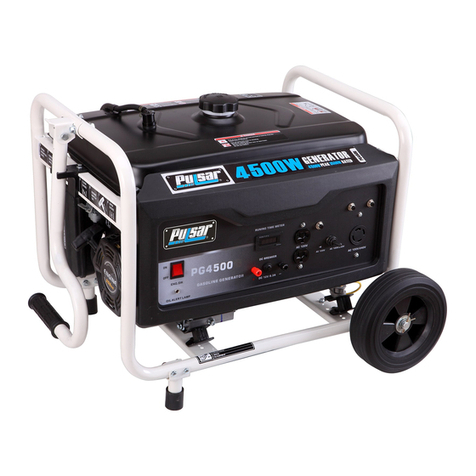
Pulsar
Pulsar PG4500 owner's manual
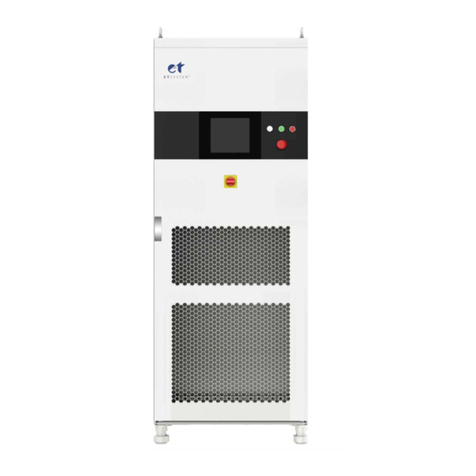
Et system
Et system EAC-4Q-KS Series manual
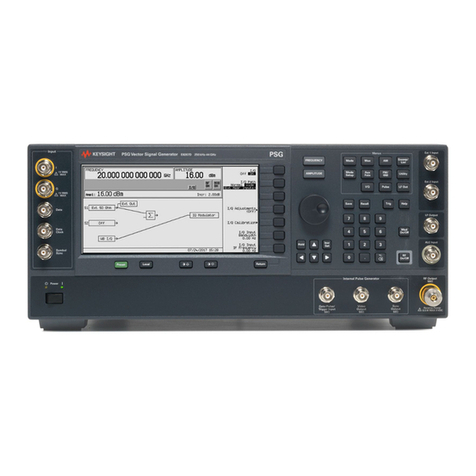
Keysight Technologies
Keysight Technologies E8267D Installation note

iPower
iPower SUA12000EDCO Operator's manual

Generac Portable Products
Generac Portable Products 10000EXL owner's manual

GENERGY
GENERGY ROBUSTA Series Instructions for use





